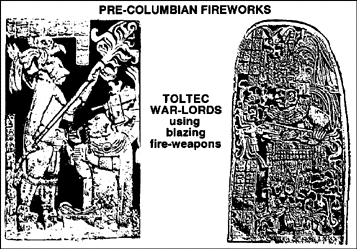spiritofatlantis.com | Duane K. McCullough

The Metal Ages of Man.
Conventional history would have us believe that the Iron Age began in c. 800 B.C. somewhere in the Middle East. This belief
assumes the idea that New World natives never used iron making technology before the European visitors arrived nearly five
centuries ago. A new theoritical view based on anthropological and archeological data now challenges this conventional
assumption.
V3
Chapter 4: The Metal Ages of Man
1/ Why does conventional anthropological literature portray
the idea that Columbus or the Vikings - or even Sino-seafarers
were the first true "discovers" of the New World?
2/ Is it because writers of civil history have for centuries
measured the cultural evolution of humanity not on language
superiority, but on the basic technological concept of the timely
development of metallurgy?
3/ Since the time of the Spanish Conquest, native cultures of
America seemed to be ignorant of iron weaponry - and therefore
historians have assumed that the "Iron Age" began in
the Old World first where the technology of creating stronger
iron weaponry has had more time to advance over earlier bronze
weaponry.
4/ Yet this five-hundred year old assumption is currently
being challenged by new archeological revelations that suggest
the science of metallurgy was once long ago more advanced in the
New World than in the Old World.
5/ While the Hittites of the Old World were making iron
swords, the intercontinental seafaring Phoenicians were shaping
iron into strong and flexible chains for safely anchoring
offshore during their long perilous voyages throughout the
coastal and oceanic waterways - which suggest the first true use
or need of iron was for nautical trade reasons and not for
militaristic reasons.
(Recent discoveries of amphora jugs at Port Royal in the Bay
Islands north of Honduras suggest the Phoenicians - or some other
trans-Atlantic seafaring culture, were trading and sharing
knowledge between the New and Old Worlds long before Columbus or
the Vikings ever set sail westward)
[According to several studies, evidence exists that certain
pre-Columbian buildings in the northern Yucatan area once used
iron reinforcement techniques which have since rusted away]
6/ The invention of guns made from iron or iron alloys - and
the exploding metallic powders that go with them are also thought
to be first discovered in the Old World, however this belief can
also be challenged by new archeological discoveries.
(The science of fireworks may have originated from the desire to
make high temperatures necessary for fusing clay into high-grade
ceramic pottery - in fact, the porcelain ware of China was the
result of understanding how to fuse feldspar materials into
strong and durable shapes by "igniting" manganese oxide
which would create very high temperatures during the baking
process)

Pre-Columbian Fireworking Technology.
The use of "fire-weapons" by Toltec war-lords to psychologically scare victims into submission, is a view found on
a stele in Central America. Other stele artwork also depict the use of hand held "flaming fire-rods". Such technology
was not available according to conventional history.
7/ There exists several stone idols or stele in Central
America that depict Toltec war-lords holding what appears to be
some sort of "flaming gun" or "blazing rod", whereby, like Chinese physiological
weaponry, fireworks were once used - but unlike the Spanish
Conquistadors, did not use any projectile in the gun.
(The incendiary substance used by Byzantine warships - known as
"Greek fire", became more active when water was added
but was not used like gun powder to propel objects of harm)

Pre-Columbian Ceramic Technology.
Evidence of the use of very high temperature technology can be found in Central America from before the
Spanish Conquest. Such technology was not available according to conventional history.
8/ Other artifacts have recently been discovered in Central
America that also suggest a high degree of metallurgical
technology - such as certain ceramic sculptural items that needed over
1500 degrees Fahrenheit to make - or even a skull artifact found in
the eastern Yucatan region made from molten glass.
(Speaking of fusible materials, there exists an incendiary
substance known as "thermit" which is a mixture of
aluminum and ferric-oxide powders that when ignited by powdered
magnesium yields blasting temperatures up to 3000 degrees
Fahrenheit and is capable of melting solid iron - in fact, many
modern solid rocket fuel formulas are basically the same
substance)

Pre-Columbian Glass working Technology.
More evidence of the use of very high temperature technology can be found in Central America from before
the Spanish Conquest. This glass skull that some believe may have been cut from a large quartz crystal,
could have been created by smelting silicate substances to temperatures greater than 1800 degrees fahrenheit.
Such technology was not available according to conventional history.
9/ However, perhaps the most remarkable and fantastic example
of man's ability to manipulate metal was the titanic technique
used to create several monumental metallic projects of long ago -
one particular project from Biblical times was the spectacular
spire once known as the "Tower of Babel".
Return to the Volume 3



